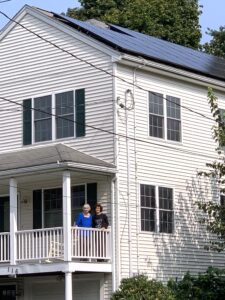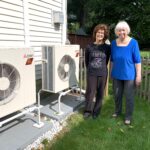 Friends and condo neighbors Anne Hayek and Marilyn Shesko are on a journey — not a road trip, but rather an effort to drastically reduce the carbon footprint of their adjoining duplex units. Constructed in 2002, each 1860-sq.-ft unit was originally equipped with powerful central air conditioning units outside and gas furnaces delivering forced-hot-air heating.
Friends and condo neighbors Anne Hayek and Marilyn Shesko are on a journey — not a road trip, but rather an effort to drastically reduce the carbon footprint of their adjoining duplex units. Constructed in 2002, each 1860-sq.-ft unit was originally equipped with powerful central air conditioning units outside and gas furnaces delivering forced-hot-air heating.
Harnessing Solar Energy: The project began in 2013 on their wonderfully sunny roof, with the installation of solar panels which produce between 6700-6800 kWh of electricity for each household every year. For several years the electricity produced was more than was used, with the excess going into the grid and the credit donated to charity.
Tightening up. Over the years, steps were taken to boost the homes’ energy efficiency. Anne and Marilyn took advantage of Mass Save no-cost home energy assessments, sealed and added insulation to the ductwork in the attic, with much of the cost being covered by Mass Save rebates.
Transitioning to all electric. In 2020, with the heating and cooling equipment approaching the end of its useful life, the two households made a major decision. Rather than replacing the existing equipment with the same type of new equipment, they decided to look into converting to heat pump technology. Marilyn and Anne sought advice from Ed Quinlan, Green Needham’s “Ask the Expert” energy advisor. After examining their energy usage, expenditures, and the characteristics of their units (especially their surplus solar electricity and weatherization efforts), Ed believed that they could go all electric while keeping their utility expenses about the same, which was an important goal for them. Ed continued to advise them throughout the process of getting bids and making decisions.
Good-bye to gas. The project of converting both duplex units to heat pump technology was subsidized by the Massachusetts Clean Energy Center as part of a pilot program. The gas furnaces were removed (this is no longer a requirement), the AC units were removed, the refrigerant piping was replaced, but the existing ductwork and diffusers were reused. The installer carefully evaluated the building to size the new equipment properly, leak-testing the ductwork and doing a blower door test to measure the homes’ air leakage. For each unit, the existing gas-fired domestic hot water heater was replaced with a 50-gallon heat pump water heater. Heating, cooling, and hot water were now all electric.
What about operating cost? For both households, electricity use, now the source of heating, increased substantially. The excess solar energy was used up and additional electricity came from the grid. Gas bills, however, decreased to a minimal amount (from a stove in Anne’s unit and gas fireplaces in both). Thanks to the solar panels (which produce about 75% of electricity needed), weatherization efforts, and energy conservation measures such as moderate thermostat settings and honeycomb shades, bills have been almost the same as they were before the transition. To power their modestly sized condo, Anne and her family spend less than $100 a month for electricity, which includes charging up their plug-in hybrid Chevy Volt. Marilyn’s annual electric bills are under $70 per month. Before the heat pumps were installed, her annual gas bills for heat and hot water were over $90 per month.
The verdict. Anne and Marilyn are both very happy with the system. Since the existing ductwork was used, installation was relatively simple. The heat and cooling is even, quiet, and comfortable. Their homes’ carbon footprints are down about 60%, and as the grid gets greener, this will improve even more. And when Community Electricity Aggregation (Needham Power Choice) becomes available in Needham, there will be options for getting electricity with even more renewable energy.
The two households did need supplemental heating when temperatures were below zero, but that has happened only rarely. Learning to program and operate the system is more complicated, and they are still learning. Marilyn emphasizes that she is concerned about the livability of the environment for her grandchildren and the many ways in which fossil fuels cause damage. Anne agrees. “We’re super happy about the lower carbon footprint,” she says. “If there’s a learning curve and adjustments to make, we’re more than willing to do it.”
Energy advisor Ed Quinlan points out that Anne and Marilyn did things the right way. They planned ahead rather than waiting until their heating system broke down, which would have put them in an emergency situation. The pilot program they used is no longer available, but generous incentives are still in place. The Mass. Clean Energy Center website offers a wealth of information, including graphics, videos, and text about cost, rebates, technology explanations, and customer stories. And if you have questions about your own project, you can contact Ed through Green Needham’s Energy Coaching Program.
This is the second in a series of blog posts that will feature local examples of moving toward Net Zero Energy, both with new construction and with retrofits of existing homes.


